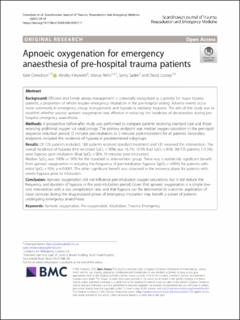| dc.contributor.author | Crewdson, K. | |
| dc.contributor.author | Heywoth, Ainsley | |
| dc.contributor.author | Rehn, Marius | |
| dc.contributor.author | Sadek, Samy | |
| dc.contributor.author | Lockey, David | |
| dc.date.accessioned | 2021-08-24T14:15:39Z | |
| dc.date.available | 2021-08-24T14:15:39Z | |
| dc.date.created | 2021-05-12T16:14:14Z | |
| dc.date.issued | 2021-01 | |
| dc.identifier.citation | Crewdson, K., Heyworth, A., Rehn, M. et al. (2021) Apnoeic oxygenation for emergency anaesthesia of pre-hospital trauma patients. Scandinavian Journal of Trauma, Resuscitation and Emergency Medicine, 29 (1):10, 1-7. | en_US |
| dc.identifier.issn | 1757-7241 | |
| dc.identifier.uri | https://hdl.handle.net/11250/2771039 | |
| dc.description.abstract | Background
Efficient and timely airway management is universally recognised as a priority for major trauma patients, a proportion of whom require emergency intubation in the pre-hospital setting. Adverse events occur more commonly in emergency airway management, and hypoxia is relatively frequent. The aim of this study was to establish whether passive apnoeic oxygenation was effective in reducing the incidence of desaturation during pre-hospital emergency anaesthesia.
Methods
A prospective before-after study was performed to compare patients receiving standard care and those receiving additional oxygen via nasal prongs. The primary endpoint was median oxygen saturation in the peri-rapid sequence induction period, (2 minutes pre-intubation to 2 minutes post-intubation) for all patients. Secondary endpoints included the incidence of hypoxia in predetermined subgroups.
Results
Of 725 patients included; 188 patients received standard treatment and 537 received the intervention. The overall incidence of hypoxia (first recorded SpO2 < 90%) was 16.7%; 10.9% had SpO2 < 85%. 98/725 patients (13.5%) were hypoxic post-intubation (final SpO2 < 90% 10 minutes post-intubation).
Median SpO2 was 100% vs. 99% for the standard vs. intervention group. There was a statistically significant benefit from apnoeic oxygenation in reducing the frequency of peri-intubation hypoxia (SpO2 < =90%) for patients with initial SpO2 > 95%, p = 0.0001. The other significant benefit was observed in the recovery phase for patients with severe hypoxia prior to intubation.
Conclusion
Apnoeic oxygenation did not influence peri-intubation oxygen saturations, but it did reduce the frequency and duration of hypoxia in the post-intubation period. Given that apnoeic oxygenation is a simple low-cost intervention with a low complication rate, and that hypoxia can be detrimental to outcome, application of nasal cannulas during the drug-induced phase of emergency intubation may benefit a subset of patients undergoing emergency anaesthesia. | en_US |
| dc.language.iso | eng | en_US |
| dc.publisher | BioMed Central | en_US |
| dc.rights | Navngivelse 4.0 Internasjonal | * |
| dc.rights.uri | http://creativecommons.org/licenses/by/4.0/deed.no | * |
| dc.subject | anestesi | en_US |
| dc.subject | pre-hospitale tjenester | en_US |
| dc.title | Apnoeic oxygenation for emergency anaesthesia of pre-hospital trauma patients | en_US |
| dc.type | Peer reviewed | en_US |
| dc.type | Journal article | en_US |
| dc.description.version | publishedVersion | en_US |
| dc.rights.holder | © The Author(s). 2020 | en_US |
| dc.subject.nsi | VDP::Medisinske Fag: 700::Klinisk medisinske fag: 750::Traumatologi: 783 | en_US |
| dc.source.pagenumber | 1-7 | en_US |
| dc.source.volume | 29 | en_US |
| dc.source.journal | Scandinavian Journal of Trauma, Resuscitation and Emergency Medicine | en_US |
| dc.source.issue | 1 | en_US |
| dc.identifier.doi | 10.1186/s13049-020-00817-7 | |
| dc.identifier.cristin | 1909787 | |
| dc.source.articlenumber | 10(2021) | en_US |
| cristin.ispublished | true | |
| cristin.fulltext | original | |
| cristin.qualitycode | 1 | |

